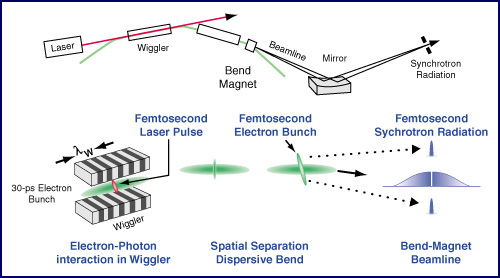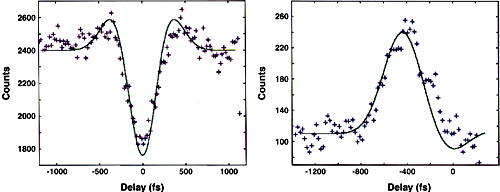
Laser Time Slicing Promises Ultrafast Time Resolution
Scientists from Berkeley Lab have generated 300-femtosecond pulses of bend-magnet synchrotron radiation at the Advanced Light Source (ALS) with the aid of a laser "time-slicing" technique. Their proof-of-principle experiment demonstrates that this technique is a viable one for producing ultrashort pulses of x rays. An ALS bend-magnet beamline will soon be commissioned that will be dedicated to time-resolved x-ray diffraction, EXAFS, and other techniques capable of probing the long-range and local structure of matter on a femtosecond time scale.
|
Atomic motion on the fundamental time scale of a vibrational period (about100 fs), via the making and breaking of chemical bonds and the rearrangement of atoms, ultimately determines the course of phase transitions in solids, the kinetic pathways of chemical reactions, and even the efficiency and function of biological processes. A thorough understanding of such dynamic behavior is a first step to being able to control structural evolution, and it is expected to have important scientific applications in solid-state physics, chemistry, materials science, and biology. X rays can provide the requisite structural information, and ultrafast x-ray science is an emerging field of research in which x-ray techniques are used in combination with femtosecond lasers to probe structural dynamics. However, the tremendous potential scientific impact of this research area is so far largely unfulfilled, owing to the lack of adequate x-ray sources. For example, the pulse length of a synchrotron x-ray source is limited by the bunch length of the electron beam in the storage ring, around 30 ps at the ALS. In early 1996, Alexander Zholents and Max Zolotorev of Berkeley Lab's Center for Beam Physics proposed the laser time-slicing technique as a way to achieve effective bunch lengths in the femtosecond range. At the heart of the proposal was the use of a high-power, femtosecond laser synchronized with the electron bunches so that a pulse of laser light passed collinearly with an electron bunch through an undulator or wiggler. The high electric field of the shorter laser pulse modulated a portion of the longer electron bunch, with some electrons gaining energy and some losing energy. Subsequently, when the energy-modulated electron bunch reached a bend magnet (or other section of the storage ring with a nonzero dispersion), a transverse separation occurred. A collimator or aperture selected the synchrotron radiation from the displaced bunch slices.
|
Femtosecond Flashes |
||||

To demonstrate the laser bunch-slicing technique, a team led by Robert Schoenlein was established with members drawn from Berkeley Lab (Materials Sciences Division, the Center for Beam Physics, and the ALS) and the University of California (UC), Berkeley. The team made use of the 16-cm-period wiggler that illuminates Beamline 5.0.2, a test chamber on bend-magnet Beamline 6.3.2, and a high-power titanium-sapphire laser. To verify the femtosecond time structure, they first imaged visible light from Beamline 6.3.2 onto a nonlinear optical crystal along with a delayed 50-fs cross-correlation pulse from the laser system. Then they counted photons at the sum frequency of the two pulses as a function of delay between the modulating and the cross-correlation laser pulses. An adjustable knife edge located in the beamline at an intermediate image plane provided a means to select radiation from different transverse regions of the electron beam. In this way, they measured a dark 300-femtosecond hole in the central core of the synchrotron radiation and a bright 300-femtosecond peak in the wing of the synchrotron radiation. 
As the next step in the growing femtosecond x-ray science program at the ALS under the leadership of Schoenlein and Roger Falcone of UC Berkeley, a bend-magnet beamline (Beamline 5.3.1) has been built and will soon begin commissioning. Initial experiments will include time-resolved x-ray diffraction, EXAFS, and NEXAFS (XANES). Research conducted by R.W. Schoenlein, S. Chattopadhyay, C.V. Shank, A.A. Zholents, and M.S. Zolotorev (Berkeley Lab); H.H.W. Chong (University of California, Berkeley); and T.E. Glover and P.A. Heimann (ALS). Research funding: Office of Basic Energy Sciences (BES), U.S. Department of Energy. Operation of the ALS is supported by BES. Publication about this research: R.W. Schoenlein, S. Chattopadhyay, H.H.W. Chong, T.E. Glover, P.A. Heimann, C.V. Shank, A.A. Zholents, and M.S. Zolotorev, "Generation of Femtosecond Pulses of Synchrotron Radiation," Science 287, 2237 (2000).
ALSNews Vol. 156, July 12, 2000 |
|||||
More ALS Science